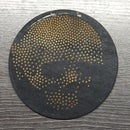Introduction: Multi-Touch Sensor Lamp (with 240Mhz :) )
I wanted to build a small lamp with touch sensors.
Some Wood, an ESP and that's it.
This was a very easy build which turned out quite well.
Four buttons in total. Each button can be assigned with three states in WLED.
Tap, Double-Tap, Hold
So there are 12 buttons. And these can also start complete "playlists".
WLED is quite cool. And everything is adjustable via the webinterface.
Supplies
- i used a 70x70mm log
- an esp32
- some ws2812 LEDs
- welding wire or brass wire
- some wires for soldering
- some basic tools for cutting and drilling (wood)
Step 1: Woodworking
As allways, it depends on your possibilities and tools, how you build this lamp.
I wanted to try how high i can cut with my scroll saw.
Well ... 70mm :)
First cut: 20mm, full length. This part will be the "roof".
Second cut: again 20mm, to make the lower part square.
The roof got a 12mm groove milled.
The picture makes it very clear how it was made.
The lower part needed some fine line-like cuts.
This job was done (gently) again with the scoll saw (and a very new and very fine blade).
Just as deep as needed, to press fit the welding wires.
Those welding wires where bended with tongs. You can bend them several times without breaking them.
Brass works too, but i didn't have brass rods, which are thick enough.
And welding wires are a little bit harder.
To wire the LEDs with the EPS, you have to drill a 3mm hole from back to front.
Bring/hammer/press the welding wires into the wood, glue the two parts together.
Step 2: Wiring
Start with soldering the wires to the led-strip.
You'll need 3 or 4 wires. Probably 3.
And push those wires through the 3mm hole. Now you can glue the LED-Strip into the 12mm groove.
My ESP32 doesn't have a 5V output-PIN, so i had to solder directly to the USB.
LED-Strip connection:
Well, ground to ground, 5V to 5V, and Data to GPIO18.
You don't have to worry that much about the DataPin, because you can change it later in the WebIF.
Touch-Buttons i've used:
4, 27, 2, 13
Again, don't worry too much about those Pins. They can be assigned in the WebIF.
As mentioned before: WLED is quite cool.
Step 3: Software
Thats the easiest part, because the whole WLED-Project is very well ducemnted.
-> https://github.com/Aircoookie/WLED
The ESP-Flasher can be found here:
-> https://github.com/esphome/esphome-flasher/releases
Connect your ESP, start the flashing SW, select the port, select the bin (*.esp32.bin) and flash.
That's all.
After flashing, you can connect with WLAN to the ESP WLAN Manager which will guide you through the network-setup.
After that, just connect to the IP and start your configuration.
Start with settings/LED Preferences.
Best part: the first touch button is allready configured with on/off and brightness controll.
To program a touch-button, you need two steps.
First: assign a preset (under the preset button)
Then assign this preset to a button (Time & Macros)
Step 4: Final Thoughts
After all, this lamp could have a bit more weight.
It works as expected, has it's own Webinterface and operates with a 240MhzESP.
Did someone say "overdose" :)
Thank you for reading.
If you liked it, please vote for me

Participated in the
Make it Glow Contest













